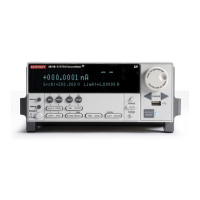2600S-901-01 Rev. C / January 2008 Return to Section Topics 2-37
Series 2600 System SourceMeter® Instruments Reference Manual Section 2: TSP Programming
Details on loadscript and loadandrunscript are provided as follows:
loadscript
loadscript name
where: name is the user-assigned name for the script.
The loadscript shell command loads the script into the run-time environment. The script can be
assigned a name or it can be left nameless. If assigning a name that already exists for another
loaded script, the old script will be overwritten with the new script.
If a script is not named when it is loaded into the run-time environment, it will be lost when another
script is loaded or when the Series 2600 is turned off. After loading the anonymous script, use the
run()or script.run() command to run it.
A special name for a script is autoexec. After an autoexec script is saved in
non-volatile memory, the script will automatically run after the Series 2600 is
powered on and all autorun scripts have been executed. For details, see “Autoexec script” and
“Autorun scripts” later in this section.
loadandrunscript
loadsandrunscript name
where: name is the user-assigned name for the script.
These commands are similar to the loadscript commands except that the script will execute
(run) after it is loaded into the run-time environment. Also, the autorun attribute for a named script
will be set to “yes” (see “
myscript.autorun” later in this section).
Saving a user script
A created and loaded script does not have to be saved in non-volatile memory of the Series 2600
before it can be run. However, an unsaved script will be lost when the Series 2600 is turned off.
Saving a named script
Only a named script can be saved in non-volatile memory of the Series 2600. After creating and
loading a named script, use one of the following commands to save it.
myscript.save()
myscript.save("name")
where: myscript is the user-defined name of the script.
name is a new name for the script that is assigned by the user. Using this function is
equivalent to the “Save As” file menu item in the Test Script Builder.
Either of the above save commands will save the script in non-volatile memory. If a script is not saved
in non-volatile memory, the script will be lost when the Series 2600 is turned off.
The myscript.save() command saves the script under the name that it was originally created
and loaded. The
myscript.save("name") shell command is used to save the script under a
different name. If you save the script to a name that already exists in non-volatile memory, it will be
overwritten.
Examples:
1. Assume a script named “test1” has been created and loaded. The following com-
mand saves the script in non-volatile memory:
test1.save()
2. To save the script named “test1” under a new name (“test2”) in non-volatile mem-
ory, send the following command:

